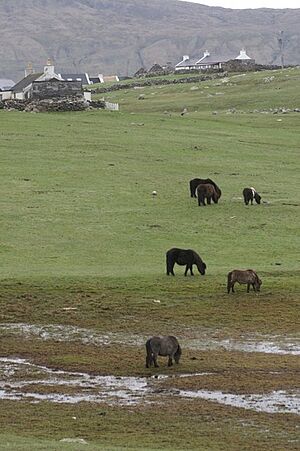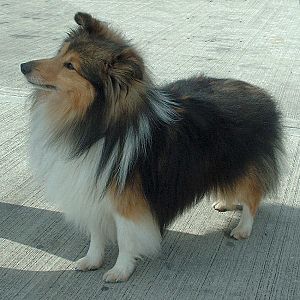Shetland animal breeds facts for kids
The amazing Shetland Islands of Scotland are a group of islands far out in the sea. Because they are so remote, animals there have developed their own special features over time. This article will tell you all about the unique and hardy animals that call Shetland home!
Contents
Meet the Shetland Pony
The Shetland Pony is a super strong and small type of pony. These ponies are usually between 71 and 107 centimeters tall at their shoulder (called the withers). They have thick, shaggy coats and short legs, which help them stay warm in the cold Shetland weather. Shetland Ponies are also very smart! People use them for riding, pulling carts, and carrying things because they are so strong for their size.
Discover the Shetland Sheepdog
The Shetland Sheepdog, often called a "Sheltie," is a popular dog breed. Long ago, the original Shetland Sheepdogs were like other northern dogs, similar to the Icelandic Sheepdog. However, over time, people in England bred them with other dogs like the Rough Collie and the Pomeranian. This is why today's Shelties look like smaller versions of the Rough Collie!
Modern Shelties are mostly loved as pets. They are also amazing at dog sports like agility courses and obedience training. Most Shelties still have a natural instinct to herd, even if it's just herding their family members! They are known for being incredibly loyal and often stay right by their human's side, like a "shadow."
Learn About Shetland Cattle
Shetland cattle are a special breed of cow that grew up to be very tough and small. People used them for both milk and beef. Today, most Shetland cattle are black and white, but in the past, they came in many different colors. These cows are similar to other traditional European cattle breeds. Sometimes, they are even used for "conservation grazing," which means they help manage natural areas by eating plants.
Explore Shetland Sheep
Sheep have lived in the Shetland Isles for at least a thousand years! They are part of a group called "Northern European short-tailed sheep." Shetland sheep are considered a "landrace" breed, which means they developed naturally over time without much human interference.
Even though Shetland sheep are small and grow slowly, they are very tough and can live a long time. They are also easy for farmers to care for. These sheep have survived for centuries in tough conditions and on simple diets. This means they do very well when they have better food and living conditions. Shetland sheep still have many of their natural survival instincts, which makes them easier to look after than many modern sheep breeds.
The Extinct Shetland Pig (Grice)
Shetland was the last place where a special type of domestic pig called the "grice" lived. These pigs were small but known for being quite fierce! Farmers in the 1800s started to prefer other pig breeds, and sadly, the grice became extinct sometime between the mid-1800s and the 1920s. Besides the Shetland Islands, the grice used to live in other parts of Scotland and Ireland.
Meet the Shetland Goose
The Shetland goose is a small, strong breed of domestic goose that comes from the islands. You can tell the males (ganders) and females apart easily: ganders are completely white, while females are white with grey patches. Shetland geese often stay with the same partner for their whole lives and are excellent at finding their own food. A few of these geese have been sent to North America, but they are not yet officially recognized there.
Discover the Shetland Duck
The Shetland duck is a small, tough breed of domestic duck also from the islands. It looks a bit like the Pomeranian duck or Swedish Blue duck. Shetland ducks are black with a white patch on their chest, like a bib. Male Shetland ducks have sky blue bills, and females have slate blue bills. Males usually weigh about 2 kilograms, and females weigh about 1.8 kilograms. Sadly, the Shetland duck is critically endangered, meaning there are very few left.
Images for kids




